Monday, 8 September 2025, Edinburgh, Holyroodhouse
Written 1 October 2025
Into the bus at 8 am today for a visit to Holyroodhouse palace, the official residence of the British monarch in Scotland. The palace gives a very good impression of being out in the country, since it's set in a vast park, but in fact you can walk there easily from downtown Edinburgh. The so-called "Royal Mile" is a straight-line route (along Lawnmarket and Canongate sts.) from the gates of Edinburgh Castle to the gates of the palace.

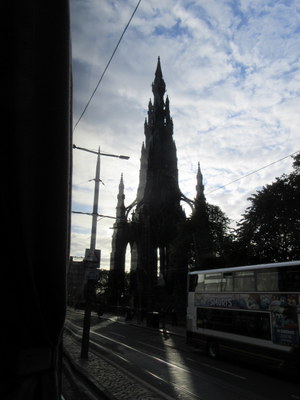 We didn't drive straight there, though, instead doing a short panoramic tour of the city while Annika pointed out major landmarks. We started by following the route David and I walked to find the ATM, then turning right on Princes St. The first thing that caught my eye was this shop called Thistle & Co., selling woolens. The city was full of businesses using "thiste" in their names. One of the most common, with branches everywhere and selling gifts and souvenirs, I think, was Thistle Do Nicely.
We didn't drive straight there, though, instead doing a short panoramic tour of the city while Annika pointed out major landmarks. We started by following the route David and I walked to find the ATM, then turning right on Princes St. The first thing that caught my eye was this shop called Thistle & Co., selling woolens. The city was full of businesses using "thiste" in their names. One of the most common, with branches everywhere and selling gifts and souvenirs, I think, was Thistle Do Nicely.
A little farther along, we passed the monument to Sir Walter Scott (shown at right). In the center underneath the spire is a nice white statue of the man, but the rest of it remains black because once again, the stone is too soft to be sandblasted and all the frilly carving might be ruined.
According to Annika, the park you can see to the right of the monument (and along which David and I strolled several times), partly hidden by a city bus, used to be a loch—the one into which suspected witches were thrown. If they sank and drowned, they were innocent; if they floated, they were fished out, dried off, and burned.
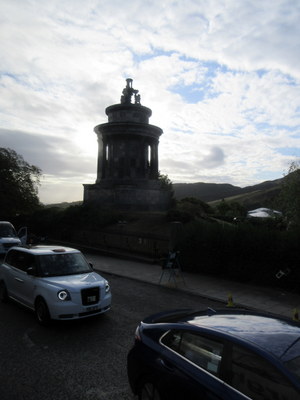
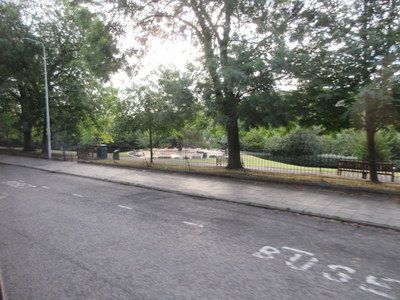 Further along, we passed the round monument to the poet Robert Burns (left, author of, among other things, the lyrics of Auld Lang Syne), and just beyond that a ring of 32 stones, representing the 32 regions of Scotland. It's not one of those ancient monumental stone rings—just a modern installation on a much smaller scale.
Further along, we passed the round monument to the poet Robert Burns (left, author of, among other things, the lyrics of Auld Lang Syne), and just beyond that a ring of 32 stones, representing the 32 regions of Scotland. It's not one of those ancient monumental stone rings—just a modern installation on a much smaller scale.
Annika pointed out that everything here is associated with George III, but before he became king. He and his wife Charlotte were married here, and they had 15 children. George St. and George's Square are named for him, and Princes St. for his two oldest sons. George's Square is graced with a little statue of Paddington Bear, sitting on a bench, but I wasn't able to make it out through the trees. Annika digressed to describe a charming little film someone made starring Paddington Bear and her majest the late queen. They had tea together, and when the little cakes ran out, Paddington produced the marmalade sandwich he always kept in his hat, and the queen revealed the secret, long the subject of intense speculation, of what she carried in her purse—a marmalade sandwich!
George IV was here for a visit in 1822, wearing full highland gear. He was the first reigning monarch to visit Scotland in almost 200 years. His visit was managed by Sir Walter Scott. A statue of him was erected to him at the time; Annika pointed it out to us in the distance as "the one with the seagull on his head."
The bus also circled through the "New Town" area, built in the late 18th and first half of the 19th centuries. It actually has a rectilinear grid of streets and wide avenues, and is such a prime example of Georgian architecture that it's included with the old town as a UNESCO World Heritage Site.
Very active in its construction was Henry Dundas, first Viscount Melville, whose statue is up on a column. He was known as the "uncrowned king of Scotland and served the United Kingdom as Home Secretary from 1791 to 1794 and First Lord of the Admiralty from 1804 to 1805.
At one point, Annika pointed out a statue of the Duke of Wellington sitting on his horse Copenhagen, but I didn't manage to get a photo.


But about Holyrood: The name means "holy cross," and the palace is called that because it was an expansion of the guest house attached to Holyrood Abbey, founded by King David I in 1128. David was the sixth son of Malcolm III of Scotland and his wife Margaret, later Saint Margaret of Scotland. Some accounts say he followed in his mother's religious footsteps, founding abbeys up and down the land, but Annika said he founded an abbey every time he did something he shouldn't, hoping to stay in God's good graces. In the case of Holyrood, he went hunting on Sunday, when he should have been in church. A stag startled his horse, which threw him, and when he came to, he saw the same stag standing over him with a glowing cross between its antlers. "Better found an abbey here," he thought, "to thank God for not having the fall kill me." The front gates (left) are topped by the silhouette of the stag with a cross between its antlers. Interestingly, Annika pronouncex "Holyrood" almost as "horrid."
The towers at the right are part of the older section of the palace, which was built in stages over several hundred years.
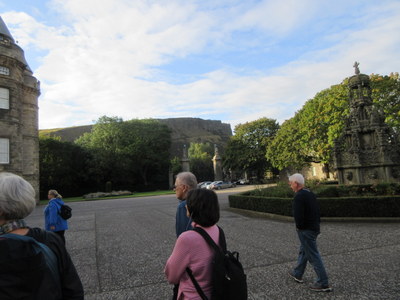
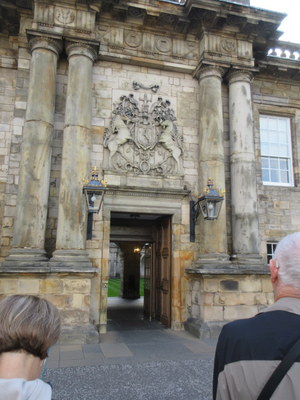 To our right as we crossed the forecourt from the gates to the entrance was this view of the Saisbury Crags. They form the backdrop of an official portrait of Queen Elizabeth II that hangs in the dining room at Holyrood.
To our right as we crossed the forecourt from the gates to the entrance was this view of the Saisbury Crags. They form the backdrop of an official portrait of Queen Elizabeth II that hangs in the dining room at Holyrood.
Above the entrance to the interior quadrangle is the coat of arms of Scotland, featuring two unicorns rather than the lion and unicorn of Enland.
Through the doorway, you can just glimpse the bright green grass of the quadrangle.
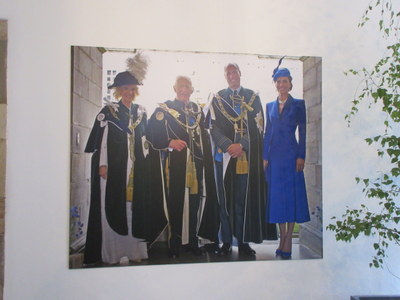
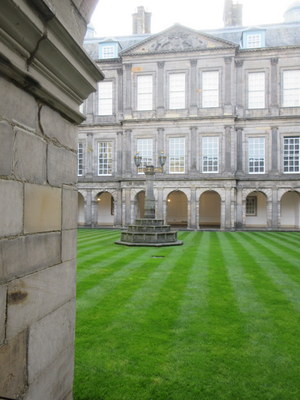 In the entryway leading to the quadrangle is this photographic portrait of King Charles, Queen Camilla, Prince William, and his wife Katherine.
In the entryway leading to the quadrangle is this photographic portrait of King Charles, Queen Camilla, Prince William, and his wife Katherine.
The grass in the quadrangle is impossibly green and lush and mowed with military precision.
I didn't happen to catch our palace docent in any of these photos, but she was absolutely the stereotype of a young Scottish woman—green tartan kilt skirt, black vest over white shirt, long, bright red, slightly frizzly hair! Tauck has a deal with the palace to let tour groups in early, an hour before it opens to the public, so we were there with just one other Tauck group; we had our own guide, and they had theirs.
Unfortunately no photography was allowed inside the palace, but Stefano had our back. He warned us not to buy the souvenire book, and sure enough, when we left, he presented each couple with a copy of the 8x10, 60-page "official souvenir booklet," full of bright, glossy photos of the rooms we had just seen. If we wanted to buy anything else, though, he said to mention Tauck for a 10% discount! I bought a bookmark and saved a quarter.
Our docent told us a lot about the palace, its history, and its current uses:
- The gate (the one featuring the stag and cross) was chosen by Victoria's Prince Albert.
- The large handsome tree we saw across an expanse of lawn is a "variegated tulip tree," though from that distance, it didn't look any more variegated than any other Liriodendron, like the ones we have around Tallahassee. I spotted a magpie in the courtyard.
- Because Holyrood is the official residence of the king in Scotland, he comes annually for an official visit, usually in July, when it's least likely to rain on the garden party, to which about 8000 guests are invited.
- During the July visit, investitures and knighthoods take place, and the king officially receives the key to Edinburgh. Holyrood is where Sean Connery got his knighthood in 2020. It's also where Queen Elizabeth II lay in state.
- Jams IV was the one who developed the the guest house of the abbey into a proper palace, but that palace is gone, replaced by newer structures.
- The quadrangle is the 17th century part of the palace, and it's designed to look just like a cloister.
- Many of the rooms have ornate plaster ceilings, but most of them unfinished—only one or two have frescos in their central medallions.
- Our tour followed the "processional route," the sequence of rooms through which people had to pass in seeking an audience with the monarch, then continued on beyond it.
- The west drawing room has a piano or harpsichord in it; it's used by the royal family for private audiences, like that of Justin Trudeau.
- Holyrood was a good stopping-off place on the way to Balmoral, so the royal family often passed through and used it for short periods. Prince albert used this room as his private study.
- George V got rid of the Victorian decor, which was bright red with green curtains and painted ceilings.
- The beautiful wood paneling in one room all came from a single tree, a 300-year-old oak that tipped up in a high wind. That is, it wasn't cut down for the purpose.
- The royal dining room has a table with additional leaves so that it can seat 6,`12, 14, or even 20 if need be. It displays portraits of Elizabeth II and her mother. The table was set with many multitier plate stands, like those used to serve afternoon tea.
- The nearby red-carpeted "throne room" is the one Queen Victoria liked to use as a dining room.
- In the 1560's Mary Queen of Scots stayed here with her husband, Henry, Earl of Darnley, who it seems was not a very nice person. Henry came to feel that Mary's relationship with her Italian secretary was too close to suit him, so one night he and some buddies came up the back stairs, dragged the secretary away from his desk, and stabbed him to death, right in front of Mary! We were shown what was supposed to be the resulting bloodstain on the floor, but the docent confided that the entire wooden floor had been replaced more than once since the incident. Early tourists were shown a stain reconstituted with pigs blood, but nowadays, they use some artificial stain to restore it as needed.
- Mary's son became James I of England (VI of Scotland). His son became Charles I, who was beheaded during the English revolution (James I's great grandson, descended from his youngest daughter, later became George I). Charles I's son became Charles II with the restoration after Cromwell died. He had 14 children but they were all illegitimate, so the crown passed to his brother, James II of England (VII of Scotland). But he was a Catholic convert, so he was forced into exile and replaced by his Protestant daughter Mary, who was married to William of Orange (a grandson of Charles I); they reigned jointly as William and Mary. When they died childless, they were succeeded by Mary's sister Anne, who also died without issue. (Poor woman; she was pregnant 17 ir 18 times, produced only 5 live births, and the only child to live past age 2 died at age 11.) That's where George I (mentioned a few lines above) came in to succeed her.
- Meanwhile, Mary (of William and Mary) had a younger half brother, James (a Catholic), who had considerable support in Scotland as the rightful successor to his father, James II. He's usually called "the Old Pretender" to the throne. His son, still Catholic, was Bonnie Prince Charlie (the young pretender). His Catholic Scottish supporters (the Jacobites, including Jamie Frasier of Outlander) were the ones defeated at Culloden. Charlie's younger brother Henry Benedict was not just Catholic but an actual Cardinal, so Culloden ended the hope of a Stuart restoration. Got all that straight?
- Now, back to Holyrood. The room that was originally Charles II's antichamber is furnished with a lovely two-keyboard harsichord and harp and elaborately inlaid cabinets.
- The only room with a finished ceiling was Charles II's bedchamber. Its central fresco was painted by Dutch artist Jacob Jacobsz de Wet II, who also did a lot of other work in the palace. Prince Albert used it, but Charles II never came back and slept here.
- The picture gallery, the Great Gallery, which runs one whole side of the palace, is the largest room in the palace and is used for especially large receptions. They've held a reception for 300 here. It's a long way from the kitchens, so a secret door behind one of the portraits leads to a butler's pantry with a warming oven.
- The Great Gallery linked Catherine of Braganza's apartments with those of Charles II; hers are in the old palace and his in the new. But she never actually came here.
- The gallery displays 96 portraits, all by Jacob de Wet. The earliest is Fergus I, who ruled in the 4th century BC, and the series continues with all the kings until Charles II and his brother after him. Kenneth I MacAlpin, at the end of the first wall, was considered the first real king of scotland. Some of the earlier personages are mythical or classical (e.g. Caractacus).
- It also houses display cases of the various honors bestowed here—sashes, badges, and medallions. A dress in tartan pattern (but not wool) worn by Queen Victoria as a teenager is on display. I'm pretty sure one like it appeared in the series Victoria that we saw on PBS.
- During the 1745 Jacobite uprising, Bonnie Prince Charlie took the city of Edinburgh (except for the castle) and stayed at Holyrood for about 6 weeks. He even gave a ball.
After our guided tour of the interior, just as the gates opened to other tourists, we were ushered to a private room in the café for complimentary tea, coffee, and pastries. After a short time to visit the gift shop, we were herded back to the bus for the ride to Edinburgh Castle.

 The decomissioned church at the left (just a short block off the Royal Mile is now the headquarters of the Edinburgh International Festival, but it also marks the entrance (just to the right of the church) to colorful, narrow, winding Victoria St., widely believed to be the model for Diagon Alley, where Harry Potter shopped for school supplies.
The decomissioned church at the left (just a short block off the Royal Mile is now the headquarters of the Edinburgh International Festival, but it also marks the entrance (just to the right of the church) to colorful, narrow, winding Victoria St., widely believed to be the model for Diagon Alley, where Harry Potter shopped for school supplies.
A couple of blocks downhill along the Royal Mile is St. Giles, where John Knox is buried.
At the right is part of the new, and architecturally controversial, Parliament building.

 Even ordinarily, traffic is restricted around the castle, but today is the third anniversary of the death of Elizabeth II, so special ceremonies were planned. In addition, only a few of the specially constructed stands set up for the Edinburgh Tattoo have been removed (it just ended). We had a considerable hike from where the bus dropped us off up to the foot of the castle. From there, David was able to get a ride in a special shuttle to join the rest of us near the top (I walked up), but because a 21-gun salute was planned for noon, the shuttle stopped running, so he had to walk back down at the end.
Even ordinarily, traffic is restricted around the castle, but today is the third anniversary of the death of Elizabeth II, so special ceremonies were planned. In addition, only a few of the specially constructed stands set up for the Edinburgh Tattoo have been removed (it just ended). We had a considerable hike from where the bus dropped us off up to the foot of the castle. From there, David was able to get a ride in a special shuttle to join the rest of us near the top (I walked up), but because a 21-gun salute was planned for noon, the shuttle stopped running, so he had to walk back down at the end.
Here, we're walking up the esplanade in front of the castle (on the side exactly opposite that we can see from our hotel), still flanked by the temporary grandstands left over from the Edinburgh Tattoo. It will take them some weeks more to finish dismantling them. The white car at the far end, next to the crane, is the shuttle that was supposed to save David the steep climb to the top. Unfortunately, it took him only about half way, so he still had a considerable climb.
I was astonished at how narrow the space between the grandstands was. Given the size and importance of the tattoo, I had expected it to be held on a vast field where 50 massed pipe bands could march and play together.
Written 7 October 2025
Again the map is probably too small to show you any detail, but it might give you an idea of the size of the place and show that, like Stirling, it sits on an outcrop surrounded on three sides by sheer cliffs. We entered at the lower end.
At the actual entrance to the castle, a statue of William Wallace stands to the right at the gate, one of Robert the Bruce to the left of it. Annika told us that, once again, the military (The Royal Regiment of Scotland) had to move out so that the city could open the castle to the public.
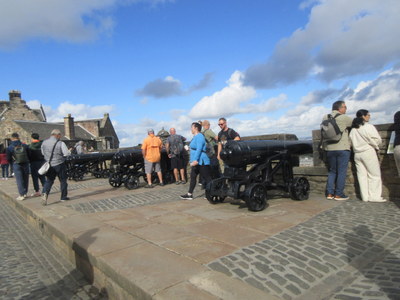
 Once at the top, we emerged onto this parapet looking out over, yes, the Firth of Forth—; firth just means estuary, and the river is the Forth. These cannons are now just ornamental, being spiked and probably filled with cement as well.
Once at the top, we emerged onto this parapet looking out over, yes, the Firth of Forth—; firth just means estuary, and the river is the Forth. These cannons are now just ornamental, being spiked and probably filled with cement as well.
Further along and a little back from the edge, I got this shot of the three modern, functional artillery pieces that would be used later to fire the 21-gun salute in honor of the three-year anniversary. Annika said there was usually only one on that spot, but that they brought in two more for the salute. The single gun fires daily to mark the time. Long ago, the city debated whether it should fire twelve guns to mark the passage of noon, as had become fasionable in other European cities of consequence. But when one of the elders suggested it would be much cheaper if they fired a single gun at one o'clock instead, the proposal was adopted.
The modern guns are a little hard to make out in the photo, but if you look just to the right of the small round stone turret and between the two guys in green vests (one in sun and the other in shadow), you can see their slender barrels facing out over parapet. In fact, when I blow the photo of the ornamental canons up, I can make out the nose of one of them (between the heads of the guy in the orange jacket and the bald guy next to him, silhouetted against the little stone dome).

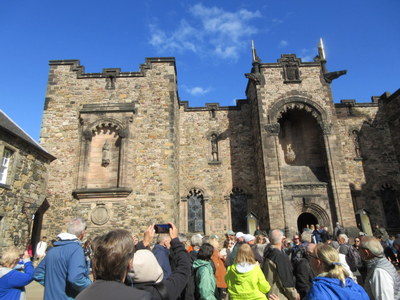 The small rectangular building at the left is St. Margaret's chapel. Just behind it is a particularly large cannon (actually a "bombard," I'm told) called Mons Meg (because she was made in the Belgian city of Mons). She was a gift to King James II (of Scotland) in 1457 She's a six-tonne siege gun and could fire a 150-kg gunstone for up to 3.2 km! She was used in battle a couple of times, and was fired in honor of Mary Queen of Scots's wedding.
The small rectangular building at the left is St. Margaret's chapel. Just behind it is a particularly large cannon (actually a "bombard," I'm told) called Mons Meg (because she was made in the Belgian city of Mons). She was a gift to King James II (of Scotland) in 1457 She's a six-tonne siege gun and could fire a 150-kg gunstone for up to 3.2 km! She was used in battle a couple of times, and was fired in honor of Mary Queen of Scots's wedding.
From there, we entered "Crown Square" described on its info panel as "the bustling heart of the castle since the 1400's."
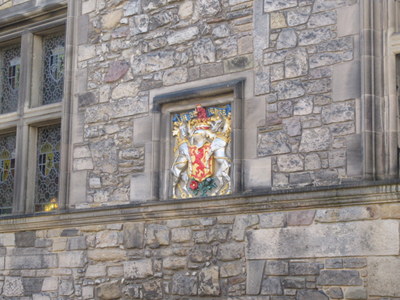
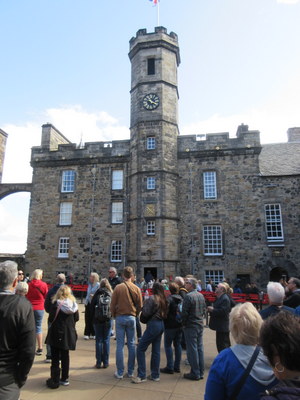 Here are the Scottish unicorns again, over a doorway, and at the right the castle's clock tower.
Here are the Scottish unicorns again, over a doorway, and at the right the castle's clock tower.
The Scottish crown jewels are here in the castle, though we didn't see them.
They are from the 16th century, much older than the English ones, which all had to be replaced after Cromnwell melted down the originals. They were hidden away for a while, during one war or another, and were hidden so well that they were lost for a while. Sir Walter Scott found them at last, in a wooden crate, in a sealed room in the castle.
James VI (I of England) was born here because because his mother, Mary Queen of Scots, didn't feel safe at Holyrood after her secretary ws murdered. She came up to the castle for its better security.
The ended at the castle, and we were to make our own way back to the hotel, with or without visiting museums or other sites in the area. It was probably only a 15- or 20-minute downhill walk, but David's feet hurt (as did my bunion when the weather cleared this morning), so we decided to have lunch in a nearby historic pub—Deacon Brodies Tavern— before getting a taxi back to the hotel. (In these cases, Tauck reimburses taxi fare.)
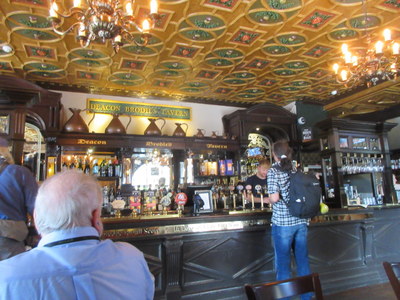
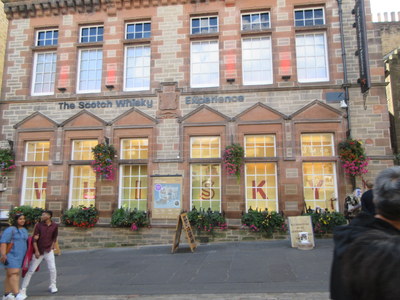 We had to wait a few minutes for the pub to open, and because it was a couple of minutes late doing so, we heard part of the 21-gun salute, fired in 7 volleys by those three guns up in the castle. The pub was called Deacon Brodie's Tavern and was originally owned by William Brodie, one of the inspirations for R. L. Stevenson's Strange Case of Dr. Jekyll and Mr. Hyde.
We had to wait a few minutes for the pub to open, and because it was a couple of minutes late doing so, we heard part of the 21-gun salute, fired in 7 volleys by those three guns up in the castle. The pub was called Deacon Brodie's Tavern and was originally owned by William Brodie, one of the inspirations for R. L. Stevenson's Strange Case of Dr. Jekyll and Mr. Hyde.
David had fish and chips, and I had sausages and mash, which I chose partly because one of the three sausages was supposedly a haggis. The mashed potatoes and onion gravy with the sausages were excellent. The rest not such a much. The sausages were okay sausages, but I had to cut into all three, examine them carefully, and taste repeatedly to determine which one differed (very subtly) from the others and must therefore be the "haggis."
The building in the right-hand photo, which was directly across from Deacon Brodies is prominently labeled "The Scotch Whiskey Experience," and I learned only later that it was to be the venue for our evening whiskey tasting.
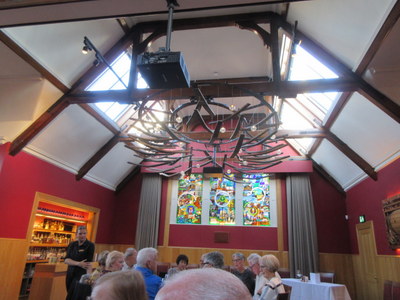
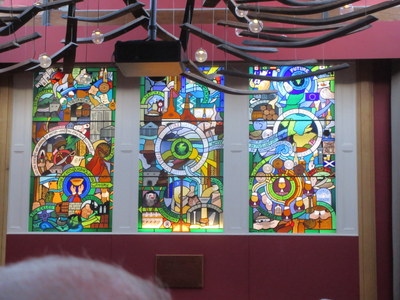 We put our feet up in the afternoon, then reconvened with the group for a whisky-tasting dinner! The route there involved retracing much of our walk from the bus toward the castle, so tour director Stefano put David and me in a taxi to within a few yards of the restaurant while the others took the bus.
We put our feet up in the afternoon, then reconvened with the group for a whisky-tasting dinner! The route there involved retracing much of our walk from the bus toward the castle, so tour director Stefano put David and me in a taxi to within a few yards of the restaurant while the others took the bus.
The tasting was in a private room at The Scotch Whisky Experience, catered by its restaurant, Amber. The place is owned by the whisky industry, and it's just a short way down the hill from the castle.
The room was beautiful. Under the high vaulted ceiling hung this chandelier made of old barrel staves. At the right is a closer view of the modern stained glass you can see on the far wall.

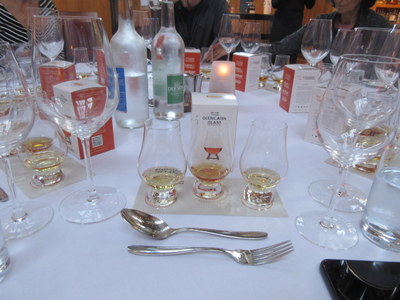 I especially liked this metal piece depicting barley "on the hoof," a malting shed, and the wooden shovel used to turn the malted barley as it toasts.
I especially liked this metal piece depicting barley "on the hoof," a malting shed, and the wooden shovel used to turn the malted barley as it toasts.
At each place setting, we found this array of three single-malt Scotches. (The box behind them held one of the glasses, designed especially for whiskey tasting, which we got to take home.) Before the meal, our hostess/guide spoke at length on the differences among the three and which courses they would go best with. I actually tasted them and I would describe them as, left to right, YUCK!, a little less YUCK!, and hmm, a little sweet, but still YUCK. I drank water with the meal.
- Single-malt Scotch whiskey has been made for a very long time, but blending only originated with the industrial revolution, in the 1860's.
- Leith Harbor, in Edinburgh, is where blending got started.
- Scotland had ca. 100 distilleries in the 1990's, now there are 152.
- Holyrood Ambir is made with vintage strains of barley. The other factor is the strain of yeast used.
- Even single malts can be blended, but only from within the same distillery.
- Aging for 15 years is optimal, because you can still afford it, but it's very good.
- The five points of whisky tasting are: (1) Color (depends on what kind of casks
were used for aging. (2) Body (as with wine, you look at the legs; fewer, fatter legs indicate more body). (3) Nose (sorry, it hurts my sinuses). (4) Palate (yuck in varying degrees). (5) Finish. It all sounds a lot like wine tasting.

 Each table received a platter of sliced bread and triangular pats of butter standing decoratively on edge.
Each table received a platter of sliced bread and triangular pats of butter standing decoratively on edge.
We had two choices for each of the first two course, then everyone had the same dessert.
I started with cullen skink (smoked haddock chowder), then chose chicken breast stuffed with haggis and wrapped in bacon. Both excellent.
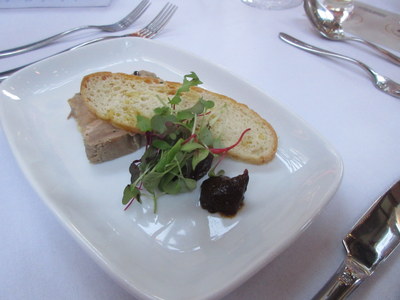
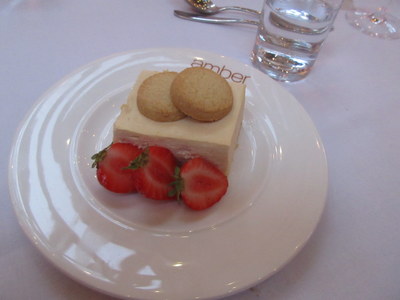 David chose the duck terrine (which he called tasteless) and the baked salmon trout. I seem to have failed to get a photo of either main course.
David chose the duck terrine (which he called tasteless) and the baked salmon trout. I seem to have failed to get a photo of either main course.
The dessert was this square, called a "liqueur slice," of slightly caramel-flavored Bavarian cream with strawberries and shortbread cookies. At the end, they brought out little squares of "Scottish tablet," which closely resembles maple sugar candy but caramel rather than maple flavored.
This was our last evening in Edinburgh. Tomorrow we head off southward.
Previous entry
List of Entries
Next entry

 We didn't drive straight there, though, instead doing a short panoramic tour of the city while Annika pointed out major landmarks. We started by following the route David and I walked to find the ATM, then turning right on Princes St. The first thing that caught my eye was this shop called Thistle & Co., selling woolens. The city was full of businesses using "thiste" in their names. One of the most common, with branches everywhere and selling gifts and souvenirs, I think, was Thistle Do Nicely.
We didn't drive straight there, though, instead doing a short panoramic tour of the city while Annika pointed out major landmarks. We started by following the route David and I walked to find the ATM, then turning right on Princes St. The first thing that caught my eye was this shop called Thistle & Co., selling woolens. The city was full of businesses using "thiste" in their names. One of the most common, with branches everywhere and selling gifts and souvenirs, I think, was Thistle Do Nicely.
 Further along, we passed the round monument to the poet Robert Burns (left, author of, among other things, the lyrics of Auld Lang Syne), and just beyond that a ring of 32 stones, representing the 32 regions of Scotland. It's not one of those ancient monumental stone rings—just a modern installation on a much smaller scale.
Further along, we passed the round monument to the poet Robert Burns (left, author of, among other things, the lyrics of Auld Lang Syne), and just beyond that a ring of 32 stones, representing the 32 regions of Scotland. It's not one of those ancient monumental stone rings—just a modern installation on a much smaller scale.


 To our right as we crossed the forecourt from the gates to the entrance was this view of the Saisbury Crags. They form the backdrop of an official portrait of Queen Elizabeth II that hangs in the dining room at Holyrood.
To our right as we crossed the forecourt from the gates to the entrance was this view of the Saisbury Crags. They form the backdrop of an official portrait of Queen Elizabeth II that hangs in the dining room at Holyrood.
 In the entryway leading to the quadrangle is this photographic portrait of King Charles, Queen Camilla, Prince William, and his wife Katherine.
In the entryway leading to the quadrangle is this photographic portrait of King Charles, Queen Camilla, Prince William, and his wife Katherine.
 The decomissioned church at the left (just a short block off the Royal Mile is now the headquarters of the Edinburgh International Festival, but it also marks the entrance (just to the right of the church) to colorful, narrow, winding Victoria St., widely believed to be the model for Diagon Alley, where Harry Potter shopped for school supplies.
The decomissioned church at the left (just a short block off the Royal Mile is now the headquarters of the Edinburgh International Festival, but it also marks the entrance (just to the right of the church) to colorful, narrow, winding Victoria St., widely believed to be the model for Diagon Alley, where Harry Potter shopped for school supplies.
 Even ordinarily, traffic is restricted around the castle, but today is the third anniversary of the death of Elizabeth II, so special ceremonies were planned. In addition, only a few of the specially constructed stands set up for the Edinburgh Tattoo have been removed (it just ended). We had a considerable hike from where the bus dropped us off up to the foot of the castle. From there, David was able to get a ride in a special shuttle to join the rest of us near the top (I walked up), but because a 21-gun salute was planned for noon, the shuttle stopped running, so he had to walk back down at the end.
Even ordinarily, traffic is restricted around the castle, but today is the third anniversary of the death of Elizabeth II, so special ceremonies were planned. In addition, only a few of the specially constructed stands set up for the Edinburgh Tattoo have been removed (it just ended). We had a considerable hike from where the bus dropped us off up to the foot of the castle. From there, David was able to get a ride in a special shuttle to join the rest of us near the top (I walked up), but because a 21-gun salute was planned for noon, the shuttle stopped running, so he had to walk back down at the end.
 Once at the top, we emerged onto this parapet looking out over, yes, the Firth of Forth—; firth just means estuary, and the river is the Forth. These cannons are now just ornamental, being spiked and probably filled with cement as well.
Once at the top, we emerged onto this parapet looking out over, yes, the Firth of Forth—; firth just means estuary, and the river is the Forth. These cannons are now just ornamental, being spiked and probably filled with cement as well.

 The small rectangular building at the left is St. Margaret's chapel. Just behind it is a particularly large cannon (actually a "bombard," I'm told) called Mons Meg (because she was made in the Belgian city of Mons). She was a gift to King James II (of Scotland) in 1457 She's a six-tonne siege gun and could fire a 150-kg gunstone for up to 3.2 km! She was used in battle a couple of times, and was fired in honor of Mary Queen of Scots's wedding.
The small rectangular building at the left is St. Margaret's chapel. Just behind it is a particularly large cannon (actually a "bombard," I'm told) called Mons Meg (because she was made in the Belgian city of Mons). She was a gift to King James II (of Scotland) in 1457 She's a six-tonne siege gun and could fire a 150-kg gunstone for up to 3.2 km! She was used in battle a couple of times, and was fired in honor of Mary Queen of Scots's wedding.
 Here are the Scottish unicorns again, over a doorway, and at the right the castle's clock tower.
Here are the Scottish unicorns again, over a doorway, and at the right the castle's clock tower.
 We had to wait a few minutes for the pub to open, and because it was a couple of minutes late doing so, we heard part of the 21-gun salute, fired in 7 volleys by those three guns up in the castle. The pub was called Deacon Brodie's Tavern and was originally owned by William Brodie, one of the inspirations for R. L. Stevenson's Strange Case of Dr. Jekyll and Mr. Hyde.
We had to wait a few minutes for the pub to open, and because it was a couple of minutes late doing so, we heard part of the 21-gun salute, fired in 7 volleys by those three guns up in the castle. The pub was called Deacon Brodie's Tavern and was originally owned by William Brodie, one of the inspirations for R. L. Stevenson's Strange Case of Dr. Jekyll and Mr. Hyde.
 We put our feet up in the afternoon, then reconvened with the group for a whisky-tasting dinner! The route there involved retracing much of our walk from the bus toward the castle, so tour director Stefano put David and me in a taxi to within a few yards of the restaurant while the others took the bus.
We put our feet up in the afternoon, then reconvened with the group for a whisky-tasting dinner! The route there involved retracing much of our walk from the bus toward the castle, so tour director Stefano put David and me in a taxi to within a few yards of the restaurant while the others took the bus.
 I especially liked this metal piece depicting barley "on the hoof," a malting shed, and the wooden shovel used to turn the malted barley as it toasts.
I especially liked this metal piece depicting barley "on the hoof," a malting shed, and the wooden shovel used to turn the malted barley as it toasts.
 Each table received a platter of sliced bread and triangular pats of butter standing decoratively on edge.
Each table received a platter of sliced bread and triangular pats of butter standing decoratively on edge.
 David chose the duck terrine (which he called tasteless) and the baked salmon trout. I seem to have failed to get a photo of either main course.
David chose the duck terrine (which he called tasteless) and the baked salmon trout. I seem to have failed to get a photo of either main course.